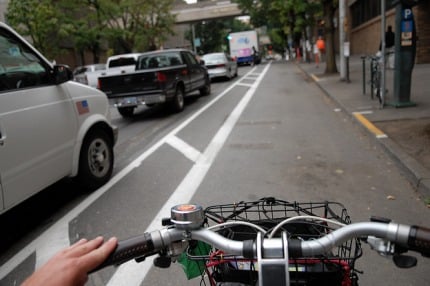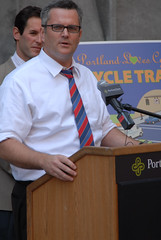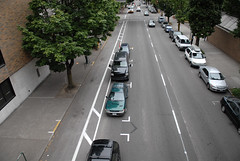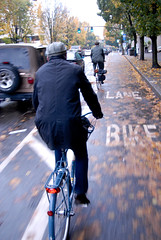
(Photos © J. Maus)
When we got our first look at the cycle track on SW Broadway one year ago this week, it was an exciting time. Mayor Adams had fulfilled one of his “100 day” promises and — after talking about it for nearly four years — we finally had our first, physically separated bikeway in the central city. Combined with new buffered bike lanes downtown (on Stark and Oak), we were off and running into a bold new era for our bike network.
“From the mayor’s perspective, it’s a success.”
— Catherine Ciarlo, Transportation Director for Mayor Adams
But what’s happened since then? Has the cycle track been a successful experiment? If so, are there plans to improve and/or extend it? What’s the current thinking from the City on separated bikeways in general?
This one year anniversary seemed like a good time to ask those questions.
Chris Monsere is an assistant professor at Portland State University. He’s the principal investigator on an evaluation being done on the cycle track to help PBOT decide how it’s working.
Reached this morning in his office, Monsere said the evaluation is primarily survey-based. They’ve been asking people who drive, walk, and bike on Broadway a series of questions about it. Monsere is still tabulating results, but says one thing that’s “jumped out” has been concerns from people trying to walk across the cycle track. “From the pedestrian survey, I noticed mentions of cyclists not stopping at the red light.” (Note that these are T-bone intersections without motor vehicle cross-traffic.) In addition to the surveys, PSU is also using video footage in their evaluation.
Echoing those preliminary survey findings, Ian Stude, the Transportation Options Manager at PSU and a member of the City’s Bicycle Advisory Committee, says “It seems people [using the bikeway] are struggling to see the traffic signals.” He’d like to see PBOT install some bike-specific traffic lights as well as curb extensions on the east side of Broadway to shorten the crossing distance. (The Mayor’s office says they’re currently searching for a location to experiment with bicycle priority signals.)
“We’d really like to see it enhanced beyond what’s there now and extended to offer that same level of comfortable treatment throughout downtown.”
— Ian Stude, PSU
Stude feels the Broadway cycle track is a “good first step.” He reports many glowing reviews from riders he describes as “interested but concerned.” But those same people, Stude adds, also express a lack of connectivity. “They want to ride that type of facility from the Broadway Bridge all the way into PSU. We’d really like to see it enhanced beyond what’s there now and extended to offer that same level of comfortable treatment throughout downtown.”
Stude hopes the evaluation and one year of having it on the ground will give PBOT the information they need to do something “really bold.” “Hopefully, what they’ll learn will give them what they need to push forward to take it to the next level.”
Mayor Adams’ Transportation Policy Director Catherine Ciarlo says they too consider the Broadway cycle track a success. “We get mostly good fedback on it. At this point, I have not gotten any negative feedback on it. From the mayor’s perspective, it’s a success.”
If the Broadway cycle track is a success and the Mayor’s office feels separated facilities are important, are there plans to improve and extend it? No. At least not right now, says Adams’ Chief of Staff Tom Miller.
“When mayor launched the cycle track last year,” Miller told me via telephone yesterday, “he said it was experimental. Based on analysis that should be done in a matter of weeks, we’ll decide whether to scrap it, extend it, or more likely do something in between.”
One issue that remains is whether or not the Broadway cycle track is a good demonstration to base future plans on. The location PBOT chose — SW Broadway from Clay to Jackson — lacks major features that need to be understood before more cycle tracks can be implemented downtown. These features include motor vehicle cross traffic (to assess right-turn and signalization issues) and businesses directly adjacent to the facility (to address what are sure to be concerns from the downtown business lobby about parking and customer access).
Ciarlo, the Mayor Adams’ transportation advisor, said a true test of a cycle track with right-turning motor vehicle movements has yet to be done. “The next challenge,” she said, “is to test a cycle track in a location where there are right turns. That’s going to be a difficult design challenge and it will be important for us to tackle that challenge.”
Researcher Chris Monsere said his evaluation will have some important results, but he also acknowledged that as for “the main thing people are worried about, those conflicts of right-turning traffic, we won’t be able to make any conclusions about that.”
PSU’s Ian Stude agreed that PBOT installed the cycle track in a “relatively safe location” for an experiment (in terms of its engineering and political difficulty), but he thinks a major driveway into a parking lot at SW College and the right turn where the cycle track ends at SW Jackson will give PBOT and PSU plenty of solid evaluation data.
“Our intention is to hit a 25% mode split by 2020 and we know that as a city we need to adopt strategies that yield more and greater separation to grow that mode split.”
— Tom Miller, Mayor Adams’ Chief of Staff
As for separated facilities in general, Ciarlo says Mayor Adams, “Continues to believe that separated facilities are an important piece of the way we will achieve our goals to attract the ‘interested by concerned’ cyclists and we plan to continue to press for them going forward.”
When asked about their progress on installing separated bike facilities, Miller pointed out several projects currently on the horizon (two-way cycle tracks planned for South Waterfront and as part of the SE Corridor Project, on NE 7th as part of the Eastside Streetcar, and on N. Williams). “Our intention is to hit a 25% mode split by 2020 and we know that as a city we need to adopt strategies that yield more and greater separation to grow that mode split.”
While both Miller and Ciarlo understand the importance of separation, it’s clear that they’re moving forward cautiously. “It’s fair to say we’re in experimental mode rather than wholesale street realignment mode,” Miller explained. “Dedicated right of way for bicycles is a brand new phenomenon for American streets, including in Portland, so we’re still working on it.”




